Basketball exercises for u9
give & go and lay-back combined
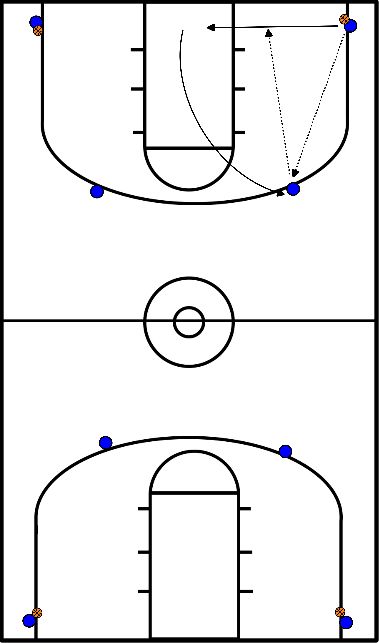
- 21 cone shot exercise, With each score the player walks behind a cone and places it on the side, The exercise is done when all the cones are distributed,
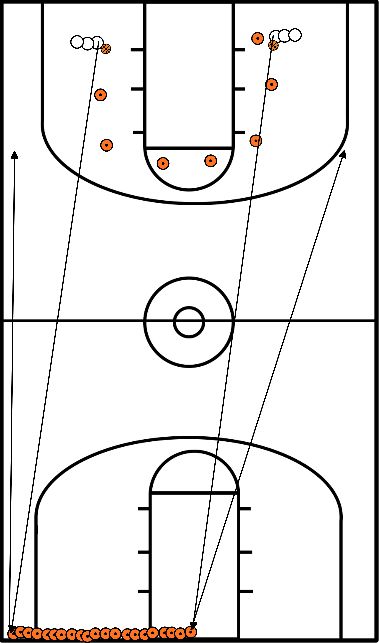
Requirements
- paste technique
Organization
- There is one ticker without the ball and two players without the ball.
- Whoever has the ball cannot be tapped without it.
- The ball may be held for a maximum of ten counts.
- If the scapegoat intercepts a ball, the ball is out of the game.
- Change the scapegoat regularly
- Depending on the amount of players adjust the size of the field.
- Running outside is not allowed.
Goal
- Free running, searching for space
- Movement
- The joy of playing
Teaching points
- Passing technique, running free and filling space
- Ball must reach other player, otherwise also out
- Dribble!
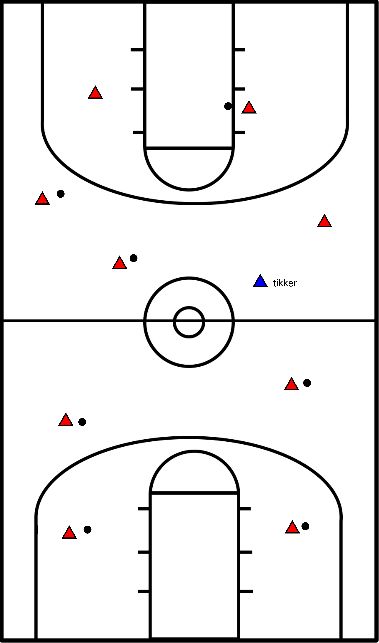
Prerequisites:
- Knowing defensive stance / attacking principle of in-out.
Organization:
- Coach gives pass on spot one (only attack after four passes/four swings)
- Attacker at spot two and three
- In/out move
- First part of the exercise 1vs1; second part 2vs2
- Passing on: offense becomes defense, defense connects and steps in as offense afterwards (stay on same side)
Goal:
- Teach correct defensive position (denial + help defense)
Teaching points:
- Quickly change position when the ball changes sides, read defenses as attackers (backdoor)
- In/out to the bucket, when defending short, get out to 1m outside 3pt line and use backdoor option, jump to the ball as defender
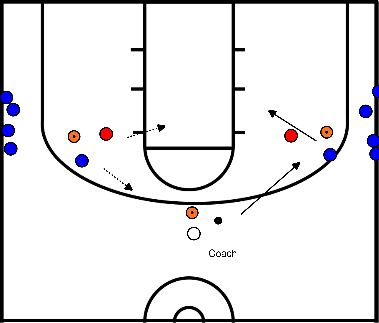
Prerequisites:
- Some game insight at fill the spot, be able to apply defensive stance (denail - helpside)
Goal:
- offence: quickly see where there is an empty spot and cut through after a pass, defence: adjust stance according to how the ball is moving
Organization
- 4 players (U10) on a spot with defence, empty spot under the ring.
- Offence: pass the ball around and make a quick cutting move towards the empty spot below the ring, other attackers move up and the empty spot is filled in by the cutting attacker.
- Defence: adjust position according to the ball. (hands on the ball, denail, weakside help on the line ring-ring)
- 5 passes (calmly), then 4vs4
- Passing on: offence becomes defence, defence steps out and then becomes offence
- Possibly start with passive defence (hands on back) depending on players' level.
teaching points
- Offence: good pass - in/out to deep bucket and high stepping out - placement of feet - attention to mistakes.
- Defence: anticipate the ball - check correct posture per spot before passing - jump-to-the-ball
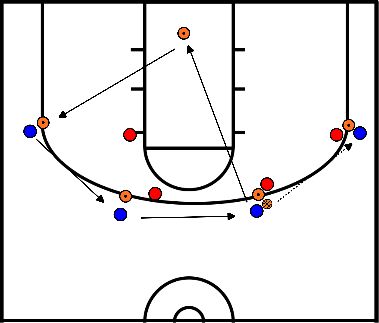
- 2 numbers a few meters apart
- x number of chesst pass
- x number of bounce passes
- x number of overhead pass
- x number of bounce pass out
- x number of baseball pass
- Add if necessary
- Defender
- pass from the dribble
Prerequisites:
- to know the defensive position
Organization:
- coach gives pass to spot 1 (only attack after 4 passes/4 swings)
- attacker on spot 2 and 3
- in/out move
- first part of the exercise 1vs1; second part 2vs2
- shuffle through: offense becomes defense, defense connects and joins in as offense afterwards (stay on same side)
Goal:
- To teach the correct defensive position (denial + help defense)
Teaching points:
- Quickly change position when the ball changes sides, read defence as attacker (backdoor)
- In/out to the bucket, when defending short, get out to 1m outside 3pt line and use backdoor option, jump to the ball.
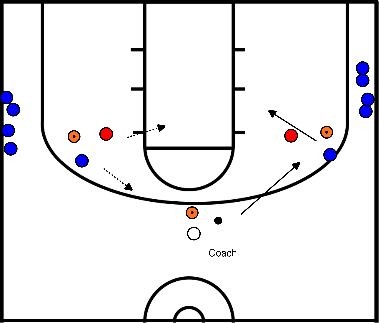
Prerequisites:
- Bit of game insight at fill the spot, be able to apply defensive stance (denail - helpside)
Goal:
- Offence: quickly see where there is an empty spot and cut through after a pass, defence: adjust stance depending on how the ball moves
Organisation
- Four players (U10) on a spot with defence, empty spot under the ring.
- Offence: Pass the ball around and make a quick cutting move towards the empty spot below the ring, other attackers move up and the empty spot is filled in by the cutting attacker.
- Defence: adjust position according to the ball. (hands on the ball, denail, weakside help on the line ring-ring)
- Five passes (calmly), then 4vs4
- Passing on: offence becomes defence, defence steps out and then becomes offence.
Teaching points
- Offence: good pass - in/out to deep bucket and high exit - jump-to-the-ball - placement of feet - attention to running faults
- Defence: anticipate the ball - check correct posture per spot before passing.
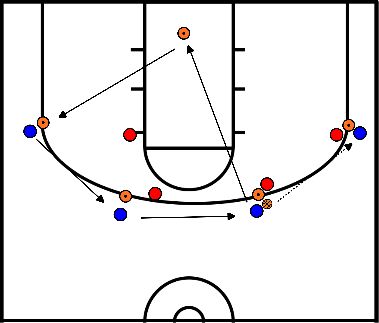
- Player sprints from the corner baseline to the first post.
- At the first post a drop step and slides towards the second post.
- From the second post, backward defensive footwork to the third post.
- At the third pole a dropstep followed by slides to the fourth pole.
- You do this until you are back at the starting point.
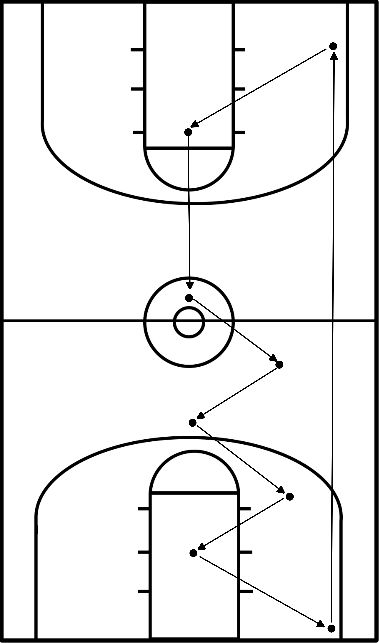
- One row on the baseline/corner and one row in the center circle with ball.
- Pass to the corner and then run to the same corner and get the ball back at the post.
- Then there are a number of possibilities such as open-step or crossover and 1 vs 0 to the basket.
- Adjuster takes care of the rebound.
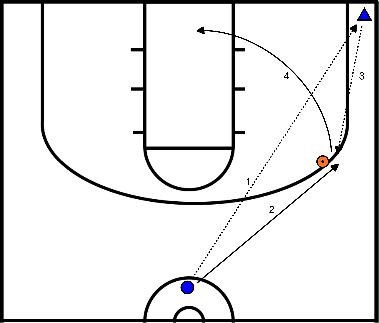
- Everyone has a ball.
- One person is the catcher and stands on the center line, the rest stands on the free throw line and tries to reach the other free throw line without being caught.
- All normal rules apply such as run and second dribble.
- If you are tagged, you also become tagged.
- Two players with one ball.
- Both players have the ball in their hands and start pulling hard to get the ball loose from the other.
- Best of 3 loser 5 push-ups.








